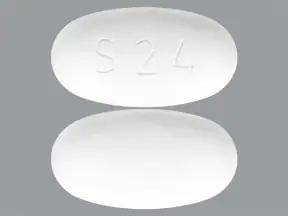Sutab Dosage
Generic name: SODIUM SULFATE 17.75g, MAGNESIUM SULFATE ANHYDROUS 2.7g, POTASSIUM CHLORIDE 2.25g
Dosage form: tablet
Drug class: Laxatives
Medically reviewed by Drugs.com. Last updated on Nov 3, 2023.
Important Preparation and Administration Instructions
- Correct fluid and electrolyte abnormalities before treatment with SUTAB [see Warnings and Precautions ( 5.1)]
- Administration of two doses of SUTAB (24 tablets) are required for a complete preparation for colonoscopy.
- SUTAB is supplied as two bottles each containing 12 tablets. Twelve (12) tablets are equivalent to one dose.
- Each SUTAB bottle contains a desiccant. Remove and discard the desiccantfrom both bottles of SUTAB the evening prior to the colonoscopy [see Dosage and Administration ( 2.2)] .
- Must consume water with each dose of SUTAB and an additional 32 ounces of water must be consumed after each dose [see Dosage and Administration (2.2) and Warnings and Precautions ( 5.1)] .
- Consume a low residue breakfast on the day before colonoscopy, followed by clear liquids up to 2 hours prior to colonoscopy.
- Do not drink milk or eat or drink anything colored red or purple.
- Do not drink alcohol.
- Do not take other laxatives while taking SUTAB.
- Administer oral medications at least 1 hour before starting each dose of SUTAB.
- If taking tetracycline or fluoroquinolone antibiotics, iron, digoxin, chlorpromazine, or penicillamine, take these medications at least 2 hours before and not less than 6 hours after administration of each dose of SUTAB.
- Stop consumption of all fluids at least 2 hours prior to the colonoscopy.
Recommended Split-Dose (2-Day) Dosage Regimen
The recommended Split-Dose (2-day) dosage regimen for adults consists of two doses of SUTAB: the first dose during the evening prior to colonoscopy and the second dose the next day, during the morning of the colonoscopy.
Instruct patients:
On the Day Prior to Colonoscopy:
- A low residue breakfast may be consumed. Examples of low residue foods are eggs, white bread, cottage cheese, yogurt, grits, coffee, tea.
- After breakfast, only clear liquids may be consumed until after the colonoscopy. Examples of clear liquids are coffee or tea (no cream or non-dairy creamer), fruit juices (without pulp), gelatin desserts (no fruit or topping), water, chicken broth, clear soda (such as ginger ale).
Day 1, Dose 1 - On the Evening Prior to Colonoscopy:
- Early in the evening prior to colonoscopy, open one bottle of 12 tablets. Remove and discard the desiccant.Remove and discard the desiccant from the second bottle and close the bottle. Use the second bottle for the second dose on the morning of the colonoscopy.
- Fill the provided container with 16 ounces of water (up to the fill line). Swallow one tablet at a time with a sip of water. Finish taking the 12 tablets and drinking the entire amount of water within 15 to 20 minutes.
- Approximately one hour after the last tablet is ingested, fill the provided container a second time with 16 ounces of water (up to the fill line) and drink the entire amount over 30 minutes.
- Approximately 30 minutes after finishing the second container of water, fill the provided container again with 16 ounces of water (up to the fill line) and drink the entire amount over 30 minutes.
If patients experience preparation-related symptoms (e.g. nausea, bloating, cramping), pause or slow the rate of drinking the additional water until symptoms diminish.
Day 2, Dose 2 – The Morning of the Colonoscopy(5 to 8 hours prior to the colonoscopy and no sooner than 4 hours from starting Dose 1):
- Continue to consume only clear liquids until after the colonoscopy.
- Repeat Step 2 to Step 4 from Day 1, Dose 1.
- If patients experience preparation-related symptoms (e.g., nausea, bloating, cramping), pause or slow the rate of drinking the additional water until symptoms diminish.
- Complete taking all SUTAB tablets and water at least two hours prior to colonoscopy.
More about Sutab (magnesium sulfate / potassium chloride / sodium sulfate)
- Check interactions
- Compare alternatives
- Pricing & coupons
- Reviews (116)
- Drug images
- Side effects
- FDA approval history
- Drug class: laxatives
- En español
Patient resources
Professional resources
Related treatment guides
Further information
Always consult your healthcare provider to ensure the information displayed on this page applies to your personal circumstances.


